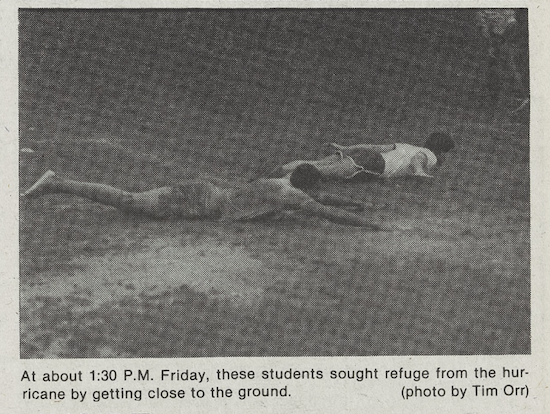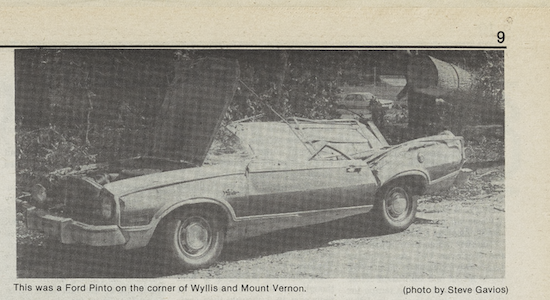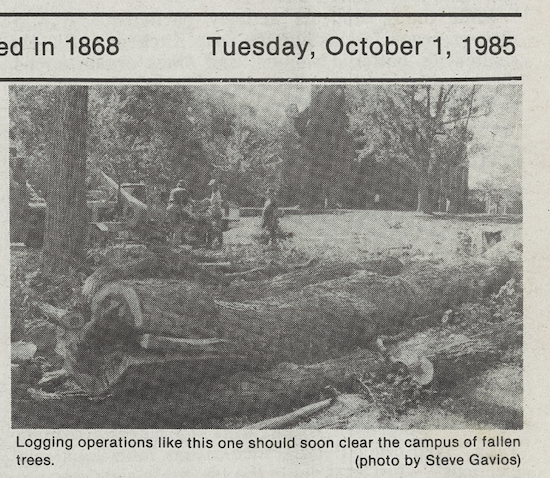
c/o Tim Orr
Connecticut’s coastline, shielded by Long Island, N.Y., and bordering the frigid North Atlantic, rarely suffers the severe hurricanes familiar to the state’s tropical, southern counterparts. Even so, cyclones that reach campus have sparked interesting reactions since the University’s beginning. Each of these early disasters pushed the importance of community into the spotlight.
1884 Atlantic Hurricane Season
140 years ago, students spending Thanksgiving break at the University saw far more than a great downpour. Thankfully, no injuries were recorded, and the damage occasioned The Argus’s first hurricane account.
“The hurricane of Sunday night made havoc with the chimneys of old North College,” detailed an unnamed reporter under the “Local” column on Nov. 25, 1884. “The bricks went clattering down at dead of night, startling many a ‘fresh’ from dreams of his first Thanksgiving home from college.”
The storm that shook North College is not named in the article. Considering the cyclone’s location and duration, the 1884 Atlantic hurricane season is a likely source. Unlike North College’s chimneys, the student body was unshaken and eager to resume classes.
“Those remaining here will enjoy the brief vacation, and join in obeying the proclamation of the President to eat, drink, and be merry,” the Argus writer reflected. “Monday morning—alas, how true!—the gates are again to be hoisted…and set the mill once more in motion. Woe to the unlucky miller who is not back on time. Prelims., censures, exclusions!”
No natural disaster could keep the millers from getting their bread. Free tickets to Elizabethan Literature talks by Professor of English Caleb Winchester, class of 1869, a renowned and charismatic critic, further cheered the returning students.
“The Literature classes have complimentary tickets for the Winchester lectures,” announced a subsequent section in the “Local” column. “Few enough are the lectures or concerts which wake this sleepy town…. We need more of such influences mixed in with the ‘grind.’”
Amid hurricane repairs and exam preparations, new activities provided connection and a sense of normalcy. Similarly, organizations on campus (e.g., WesWell and the Resource Center) host community events to break up the grind today.
1938 New England Hurricane
Standard storm behavior resumed until an unwelcome guest, with sudden strength and chance timing, derailed President James L. McConaughy’s welcome address.
“The hurricane which devastated New England struck the Wesleyan campus,” relayed an uncredited article, “Campus Stricken By Devastating Hurricane During President’s Matriculation Address,” on Sep. 26, 1938. “The trees first started falling as President McConaghy commented on the loss of one irreplaceable tree during a previous storm.”

c/o Steve Gavios
78 mile-per-hour winds forcibly uprooted the University’s prized greenery. Muddy conditions contributed to the perfect storm.
“Combined with the fact that the ground had been soaked with a week’s rain, [wind velocity] accounted for the loss of a large proportion of Wesleyan’s beautiful trees,” continued the briefing. “The President stated…though the beauty of High Street and of the campus as we knew it is gone for the present, replanting will start soon.”
Restoration required more than replanting. Roofs flew from the Honors College and Graduate Hall. Judd Hall flooded. Evacuations transported students from wrecked dorms.
“The steeple was torn from Memorial Chapel,” the unnamed Argus writer described. “A corner of the Faculty Club porch was demolished by a falling tree, and the chimney and skylight of the Winchester House were destroyed.”
In a few hours, the cyclone had rendered their campus unrecognizable. Students recognized they were living through a historic catastrophe.
“During the past week Wesleyan has undergone one of its most trying and tragic weeks in its history,” an uncredited article, “After the Storm,” reflected on Sep. 26, 1938. “The first week of school is usually one of many headaches…but this past week is one unsurpassed in its ability to create headaches.”
Although the hurricane damaged the University’s appearance, the student body swelled with pride. Rebuilding became a shared experience and a common goal.
“Our metal has been tested and has been found to be true,” rallied the anonymous author. “Let us keep in mind the spirit of cooperation which we have shown in recent days and carry this foremost in our minds and actions.”
The spirit of cooperation fueled the work ahead. An article published on Sep. 30, 1938, “College Comptroller Henderson Busy With Restoration Of Hurricane-torn Campus,” outlined present accomplishments and future goals.
“The entire college staff as well as fifty men hired in town were working extra shifts to return the college to its original beauty and routine,” reported the uncredited update. “Replanting of missing trees will probably begin as soon as the debris has been removed.”
Collaboration accelerated and sustained the construction effort. After nine days, a united Middletown had already made progress on Judd and Clark Halls, Honors College, Olin Library, the Infirmary, and the tennis courts.
1985 Hurricane Gloria
Tragically, the next hurricane, which happened in 1985, would deprive thousands at the University of power and even more of a Friday issue of The Argus. Monday’s paper, likely read by candlelight, explained the debacle.
“The Argus was unable to publish Friday due to the storm and the subsequent loss of electrical power to our printer,” an editors’ note read, published Oct. 1, 1985.
Lacking electricity and reading material, students and professors had an unusual weekend.
“Electric thermostats brought Alex Fisher ’86 no heat, and a powerless refrigerator has allowed her cottage cheese to enter ‘ever new states of decomposition’ since Friday,” then-Editor-in-Chief Aaron Schloff ’88 wrote.
On Sunday, an unexplained power startup gave students false hope for refrigeration’s return.

c/o Steve Gavios
“Fisher and housemates were tricked by a brief return of power,” Schloff continued. “‘We got all excited, and started moving all the food back into the fridge … all for nothing,’ she said sadly.”
For some, the storm clouds had a silver lining. “Students, faculty party in storm” by then-News Editor Dylan Kreuzer ’88, published alongside Schloff’s piece, uncovered another type of hurricane reaction.
“Bobby Clark, director of Public Information, reported that he saw students playing football on Andrus Field,” Kreuzer reported. “Some students also went mud sliding down Foss Hill during the worst of the hurricane.”
The hurricane field day was exciting and entirely reckless. Many shared frightening moments and expressed uncertainty.
“John Turitz ’86 watched a tree in front of his house ‘uproot itself and take some cement with it,’” Kreuzer added. “During the storm there were branches flying all over Home Avenue where he lives.”
Due to extensive power line damage, the threat of an electrical fire loomed over residents’ heads.
“Steve Almond ’88 was unfortunate enough to be over at 65 Pearl Street,” Kreuzer said. “The residents had to be evacuated to Fayerweather Gym because of a downed power line. [Almond said:] ‘We were nervous and worried about the possibility of fire.’”
Like the disasters before Hurricane Gloria, fear was met with the community and compassion.
“[Almond] added, however, that they had a great time,” Kreuzer commented. “There was a bunch of cots and plenty of blankets. We played basketball and had a good time. We were the only ones there; I was psyched.”
Then-director of Public Information Bobby Clark shared his reflections.
“Clark said he was impressed with ‘the power of elemental nature,’” Kreuzer reported from an interview. “He added, ‘Much of what we do is controlled. You don’t see unleashed power very often. It was fascinating.’”
In spite of that power, people have resolved and rebuilt the University each time, brick by brick.
Hope Smith can be reached at hnsmith@wesleyan.edu.
“From the Argives” is a column that explores The Argus’ archives (Argives) and any interesting, topical, poignant, or comical stories that have been published in the past. Given The Argus’ long history on campus and the ever-shifting viewpoints of its student body, the material, subject matter, and perspectives expressed in the archived article may be insensitive or outdated, and do not reflect the views of any current member of The Argus. If you have any questions about the original article or its publication, please contact Head Archivists Sida Chu at schu@wesleyan.edu and Maggie Smith at mssmith@wesleyan.edu.